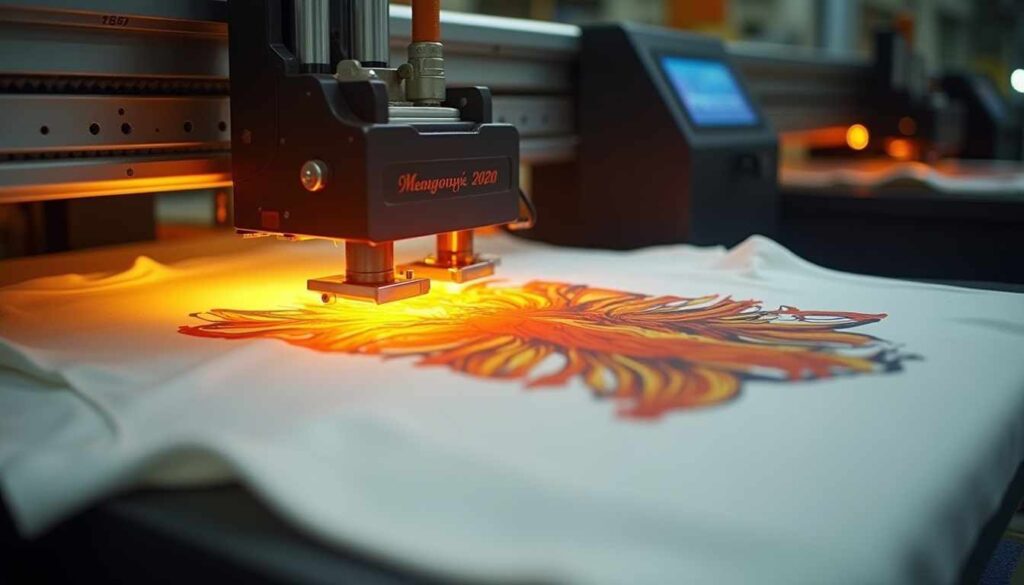DTG printing (Direct to Garment) is an advanced digital printing technology that allows ink to be sprayed directly onto fabric without intermediate steps typically found in traditional printing methods. Although offering numerous significant benefits, this technology is not yet fully understood by everyone. In this article, we’ll explore what DTG printing is, highlight its key features, and discuss its common applications in today’s printing industry.

What is DTG Printing?
DTG printing (Direct to Garment) is a digital printing technique that applies ink directly onto fabric surfaces. Unlike traditional printing methods such as silk screen printing or heat transfer printing, DTG utilizes inkjet printers to spray ink directly onto textiles. A DTG printer operates similarly to a standard office printer, but instead of printing onto paper, it prints directly onto fabric items, especially garments like t-shirts.
Outstanding Advantages of DTG Printing Technology
DTG printing offers several exceptional features, making it a superior choice for businesses and individuals seeking to produce printed garments and textile products. Here are some key advantages:
- Superior Image Quality: DTG excels at reproducing intricate, multicolored images, gradients, and fine details, delivering vivid, photographic-quality prints.
- Unlimited Color Options: Unlike screen printing, which requires color separation and screens for each color, DTG uses CMYK (and white ink) to mix and create millions of colors simultaneously.
- Soft and Natural Feel: As the ink absorbs directly into the fibers (especially on light-colored fabrics that do not require a white base), prints feel soft and breathable, without the stiffness or discomfort associated with some decal or thick screen-printed designs.
- Ideal for Small Batches and Personalization: DTG printing doesn’t require high setup costs for each design (such as making films or screens), making it perfect for short runs and print-on-demand (POD) products.
- Quick Setup Process: DTG setups are faster compared to the lengthy preparation involved with traditional printing methods, ideal for small or varied orders.
- Environmentally Friendlier (Relatively): DTG inks are primarily water-based, reducing the presence of harmful chemicals compared to traditional oil-based screen printing inks. The printing process also consumes less water and generates less waste.
How Does a DTG Printer Work?

The DTG digital printing process typically involves these essential steps:
- File Preparation: Designs need high resolution (typically 300 DPI) and appropriate file formats (PNG with transparent backgrounds preferred) to ensure sharp print quality.
- Pre-treatment: This crucial step, especially for dark-colored fabrics, involves spraying a specialized pre-treatment liquid onto the fabric and drying it. This helps the white ink adhere better and allows the CMYK inks to appear more vivid and precise. This step can be skipped on light-colored fabrics.
- Loading the Fabric: The garment is placed flat on the printer’s platen and securely positioned to prevent movement or wrinkles during printing.
- Printing: The computer sends image data to the DTG printer. Print heads move across the fabric, spraying ink precisely according to the design. For dark fabrics, a white base layer is printed first, followed by the CMYK colors.
- Heat Curing: After printing, the product undergoes heat curing to fully dry and permanently bond the ink to the fabric fibers. Typically, this involves using a heat press or conveyor dryer at temperatures around 100-150°C for approximately 60-120 seconds, depending on ink type and equipment. Proper curing ensures durability and wash resistance.
Pros and Cons of DTG Printing
To provide a balanced perspective, consider both the advantages and disadvantages:
Advantages:
- Prints complex, detailed, multicolored images clearly.
- Sharp, vibrant color quality.
- Soft, natural feel on fabric.
- Excellent for short-run, sample, and POD orders.
- No color limit in printing.
- Fast setup time per design.
- Uses environmentally friendly water-based inks.
Disadvantages:
- Higher cost per product compared to DTF when printing large batches (due to slower printing speeds and ink costs).
- Slower production speed for large batches with the same design compared to DTF.
- Limited to specific fabric types: best suited for 100% cotton or high cotton blends. Printing on polyester or blended fabrics may result in reduced quality and durability unless specialized inks and equipment are used.
- Pre-treatment required for dark fabrics, adding time and cost.
- Potentially lower colorfastness compared to high-quality screen printing if not cured properly or frequently washed with strong detergents.
- High initial equipment investment.
Popular Applications of DTG Technology Today
With its unique benefits, DTG digital printing is widely used across various sectors:
- Personalized Fashion and Local Brands: Custom t-shirts, hoodies, sweatshirts with exclusive designs and flexible quantities.
- Print-on-Demand (POD) Business: Online platforms and stores produce items only upon order placement, reducing inventory risk.
- Promotional and Event Merchandise: Printing complex logos and images for event uniforms and customer giveaways.
- Sampling: Major fashion brands quickly produce prototype garments before mass production.
- Wearable Art: Artists reproduce their work vividly and authentically on clothing.
The FlashShip team hopes this article provides clear insights into DTG digital printing technology, helping you choose the best printing solution for your business or brand. For further inquiries or specific DTG service consultations, please contact us at (+84) 852 763 445 or visit seller.flashship.net for prompt and dedicated support!

